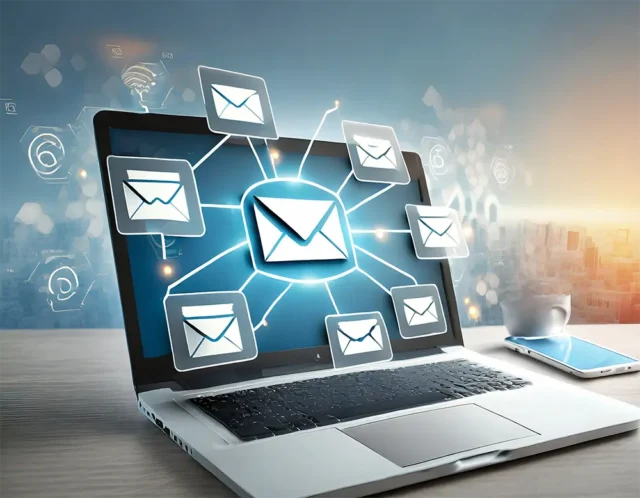Email automation is a powerful tool in digital marketing that allows businesses to streamline their communication, enhance customer engagement, and drive conversions. By automating email processes, marketers can save time and deliver personalized content to their audience at the right moment. Here’s a comprehensive guide on how to effectively use email automation in your digital marketing campaigns.

Table of Contents
Toggle1. Define Your Goals
Before diving into email automation, it’s essential to identify your goals. What do you want to achieve with your email campaigns? Common goals include:
- Increasing website traffic
- Boosting sales and conversions
- Nurturing leads
- Enhancing customer engagement
- Building brand loyalty
Defining clear objectives will guide your email automation strategy and help you measure success.
2. Segment Your Audience
Effective email automation relies on understanding your audience. Segment your email list based on various criteria, such as:
- Demographics (age, gender, location)
- Purchase history
- Engagement level (open rates, click-through rates)
- Interests or preferences
Segmentation allows you to send targeted, relevant content to different groups, increasing the likelihood of engagement and conversions.
3. Choose an Email Automation Tool
Select an email automation platform that fits your business needs. Popular options include:
- Mailchimp
- HubSpot
- ActiveCampaign
- ConvertKit
- GetResponse
These tools offer features like customizable templates, automation workflows, analytics, and integrations with other marketing tools.
4. Create Automated Email Workflows
Automated email workflows are sequences of emails triggered by specific actions or events. Here are some common types of workflows you can implement:
- Welcome Series: Send a series of welcome emails to new subscribers, introducing your brand and setting expectations for future communications.
- Abandoned Cart Emails: Remind customers about items left in their shopping carts, often with incentives like discounts to encourage completion of the purchase.
- Lead Nurturing: Send targeted content to leads based on their interests and behaviors, guiding them through the sales funnel.
- Post-Purchase Follow-Up: Thank customers for their purchase and provide information about their order, along with recommendations for related products.
- Re-engagement Campaigns: Reach out to inactive subscribers with special offers or surveys to understand their preferences.
5. Personalize Your Emails
Personalization is key to effective email marketing. Use the data you’ve collected to tailor your messages. Personalization can include:
- Addressing subscribers by their name
- Recommending products based on past purchases
- Sending birthday or anniversary greetings
- Tailoring content to match interests or behaviors
Personalized emails drive higher engagement and can significantly improve open and click-through rates.
6. Optimize Subject Lines and Preview Text
The subject line is the first thing recipients see, so it’s crucial to make it compelling. Use action-oriented language, create urgency, and keep it concise. Additionally, optimize the preview text, as it provides further context for your email. A well-crafted subject line and preview can significantly improve open rates.
7. Test and Optimize Your Campaigns
A/B testing is essential for optimizing your email campaigns. Test different elements such as:
- Subject lines
- Email content (text vs. images)
- Call-to-action buttons
- Send times and frequency
Analyze the results to determine what resonates best with your audience, and use these insights to refine your future campaigns.
8. Monitor Performance and Metrics
Regularly track the performance of your automated email campaigns using analytics provided by your email automation tool. Key metrics to monitor include:
- Open rates
- Click-through rates (CTR)
- Conversion rates
- Bounce rates
- Unsubscribe rates
Understanding these metrics will help you gauge the effectiveness of your campaigns and identify areas for improvement.
9. Ensure Compliance with Regulations
Be aware of email marketing regulations, such as the General Data Protection Regulation (GDPR) and the CAN-SPAM Act. Ensure that you:
- Obtain explicit consent from subscribers before sending marketing emails.
- Provide an easy way for recipients to unsubscribe.
- Clearly identify your business in emails and include contact information.
Compliance is essential for maintaining trust and avoiding penalties.
10. Continuously Improve Your Strategy
Email automation is not a set-it-and-forget-it solution. Continuously assess your strategies, stay updated on industry trends, and adapt your approach based on audience feedback and changing behaviors. Regularly refresh your email content and automation workflows to keep your audience engaged.
Conclusion
Email automation is a powerful component of digital marketing that can enhance engagement, streamline communication, and drive conversions. By defining your goals, segmenting your audience, and creating personalized email workflows, you can leverage automation to its fullest potential. Regularly monitor performance and optimize your campaigns to ensure ongoing success. Embrace the power of email automation to foster stronger relationships with your audience and achieve your marketing objectives.


No responses yet